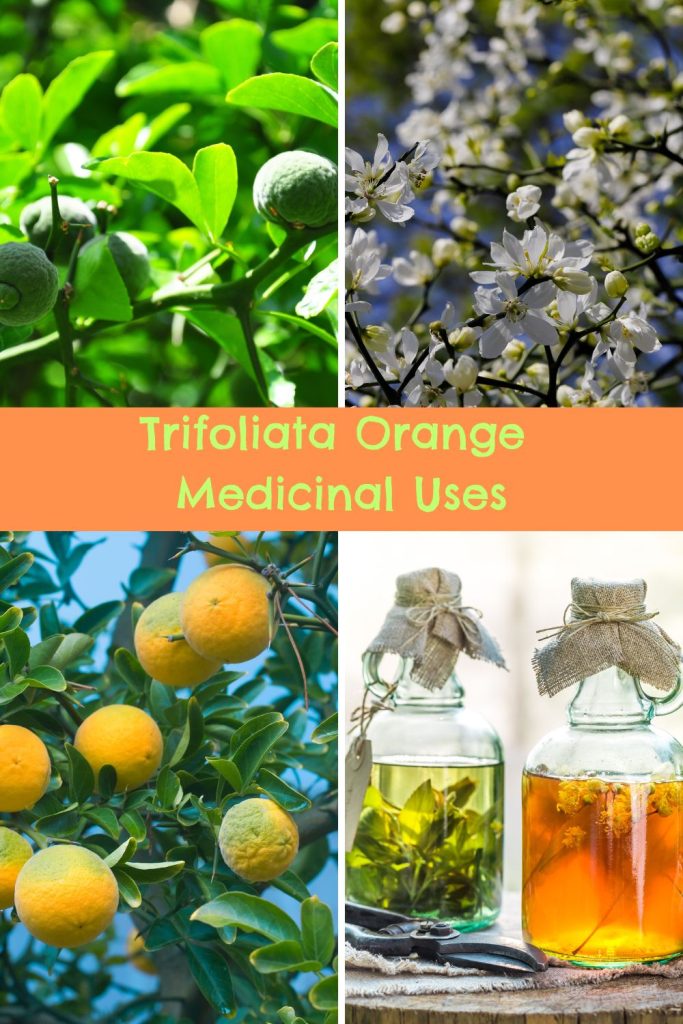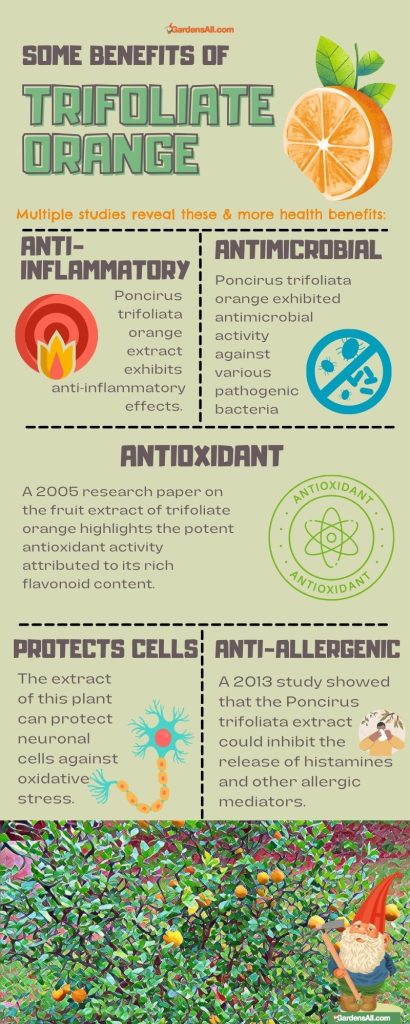WARNING: unbalanced footnote start tag short code found.
If this warning is irrelevant, please disable the syntax validation feature in the dashboard under General settings > Footnote start and end short codes > Check for balanced shortcodes.
Unbalanced start tag short code found before:
“https://pubmed.ncbi.nlm.nih.gov/19420715/)) Ponciri Fructus is a crude drug obtained from the dried immature fruits of Poncirus trifoliata. 2022 Study on the Bioactive Chemical Constituents and Pharmacological Activities of Ponciri Fructus”
We love that every part of this plant is useful! Trifoliata Orange medicinal uses and benefits have been employed in China and Korean medicine for centuries. Scientifically known as Poncirus trifoliata, this is a citrus species widely recognized for its distinctive three-lobed leaves, hard, rough-textured fruit and spiky stems.
In traditional Chinese medicine (TCM) and other traditional medicine systems, the primary parts of the Trifoliate Orange (Poncirus trifoliata) that are commonly cited for medicinal use are the fruit, roots, and occasionally the leaves. The stems and thorns, while less frequently mentioned, can also be used in some preparations.
For growers, the Trifoliata Orange is popularly used as rootstock for developing cold-hardy citrus trees.((https://pubmed.ncbi.nlm.nih.gov/32689297/))((https://www.ncbi.nlm.nih.gov/pmc/articles/PMC6576027/))
Let’s delve into some of the scientific studies that validate a few of its many medicinal benefits and uses.
Trifoliata Orange Medicinal Uses and Benefits
1. Anti-inflammatory Properties
A study conducted by Kim et al. (2012) demonstrated that extracts from Poncirus trifoliata exhibit anti-inflammatory effects. The research, which was conducted on mice, revealed that the extract significantly inhibited the production of pro-inflammatory cytokines, thereby reducing inflammation.((https://www.ncbi.nlm.nih.gov/pmc/articles/PMC7327144/))((https://www.ncbi.nlm.nih.gov/pmc/articles/PMC6743280/))
2. Antioxidant Activity
The antioxidant properties of Poncirus trifoliata have been explored in various studies. A research paper by Lee et al. (2005) highlighted that the fruit extract of trifoliate orange exhibited potent antioxidant activity, which can be attributed to its rich flavonoid content.((https://www.ncbi.nlm.nih.gov/pmc/articles/PMC3866750/))((https://www.ncbi.nlm.nih.gov/pmc/articles/PMC6576027/))
3. Antimicrobial Activity
Trifoliate orange has also been studied for its antimicrobial properties. A study by Choi et al. (2007) found that the essential oil derived from Poncirus trifoliata exhibited antimicrobial activity against various pathogenic bacteria, showcasing its potential as a natural antimicrobial agent.((https://pubmed.ncbi.nlm.nih.gov/10995330/))((https://www.ncbi.nlm.nih.gov/pmc/articles/PMC3866739/))
4. Anti-allergic Effects
The anti-allergic effects of Poncirus trifoliata were explored in a study by Shin et al. (2013), which demonstrated that the extract could inhibit the release of histamine and other allergic mediators. This shows the potential for managing allergic reactions, including anaphylaxis, based on 100% positive results in lab studies with rats, so more human studies are needed.((https://pubmed.ncbi.nlm.nih.gov/8953421/))((https://pubmed.ncbi.nlm.nih.gov/31523174/))
5. Neuroprotective Effects
Research has also explored the neuroprotective effects of Poncirus trifoliata. A study by Cho et al. (2009) demonstrated that the extract of this plant could protect neuronal cells against oxidative stress, suggesting potential applications in managing neurodegenerative diseases.((https://www.sciencedirect.com/science/article/pii/S0753332218362309))((https://pubmed.ncbi.nlm.nih.gov/19420715/))
Ponciri Fructus is a crude drug obtained from the dried immature fruits of Poncirus trifoliata.
2022 Study on the Bioactive Chemical Constituents and Pharmacological Activities of Ponciri Fructus((https://www.ncbi.nlm.nih.gov/pmc/articles/PMC9821892/))
Trifoliata Orange – Parts Used for Medicinal Purposes
In traditional medicine systems, especially in East Asia, various parts of the Trifoliate Orange (Poncirus trifoliata) have been utilized for different medicinal purposes.
Ponciri Fructus is made from the dried immature fruit of Poncirus trifoliata, and is most often the form used in Asian ethnomedicinal uses.
Here’s a general overview:
- Bark: Typically used in decoctions due to its harder nature. It can also be ground into powders or used in tinctures.
- Flowers: Often steeped to prepare herbal teas or tisanes due to their aromatic properties. They can also be used in tinctures or poultices.
- Fruit: Commonly used in decoctions, tinctures, and powders. The fruit’s rind and pulp can also be used in poultices.
- Leaves: Steeped for teas or tisanes, used in poultices, or included in tinctures. They can also be dried and ground into powders.
- Peel: The peel of the Trifoliate Orange fruit is rich essential oils and bioactive compounds. It has various medicinal applications in decoctions, teas, tinctures, and powder forms.
- Seeds: Used in decoctions, tinctures, and powders. They are also sometimes used in poultices.
- Stems: While not as commonly used as other parts, stems can be included in decoctions, tinctures, or ground into powders.((https://www.ncbi.nlm.nih.gov/pmc/articles/PMC3866739/))
- Thorns: Less commonly used, but they might be included in some traditional decoctions or tinctures.
While many parts of the Trifoliate Orange can be adapted for various medicinal forms, the specific use often depends on the traditional practices, the desired medicinal properties, and the preparation method that best extracts those properties.
Some parts of the plant, such as the fruit, are naturally more potent, however, all parts can be beneficial, especially in teas and powders.
You may also enjoy our article on fig leaves tea health benefits.

Medicinal Forms of Trifoliata Orange
- Decoctions: A decoction involves boiling the plant material in water to extract its medicinal properties. For the Trifoliate Orange, this method typically utilizes the harder parts like the roots or bark. Decoctions are commonly used in traditional Chinese medicine to harness the therapeutic benefits of these plant parts.
- Peel
- Roots
- Bark
- Tinctures: Tinctures are alcoholic extracts of plants. For the Trifoliate Orange, both the fruit and roots can be soaked in alcohol to create tinctures. This method offers a concentrated form of the plant’s medicinal properties, making it suitable for conditions that require potent remedies.
- Bark
- Fruit
- Peel
- Roots
- Stems
- Thorns
- Teas and Tisanes: Herbal teas or tisanes involve steeping the plant material in hot water. The leaves of the Trifoliate Orange are typically used for this purpose, extracting their beneficial properties in a milder form compared to tinctures or decoctions.
- Bark
- Flowers
- Leaves
- Peel
- Roots
- Stems
- Thorns
- Poultices: Poultices involve applying crushed or ground plant material directly to the skin. The leaves and, in some cases, the roots of the Trifoliate Orange can be used in this manner to address localized issues, such as inflammation or wounds.
- Leaves
- Roots
- Powders: The dried plant material is ground into a fine powder. The fruit, roots, and occasionally the leaves of the Trifoliate Orange can be processed into powders. These powders can be consumed directly, encapsulated, or mixed with other ingredients for various medicinal preparations.
- Fruit
- Leaves
- Peel
- Roots
While most herbs are safe, it’s always a good idea to consult with an expert in herbal medicine.
Is Trifoliata Orange Invasive?
Yes, especially in warmer climates such as the southeastern US, the Trifoliate Orange (Poncirus trifoliata) can be invasive. Originally native to China and Korea, it has been introduced to other parts of the world, primarily as a rootstock for citrus trees and for ornamental purposes due to its unique trifoliate leaves and hardy nature.
In areas where it’s introduced, the Trifoliate Orange can spread and establish itself in natural habitats, outcompeting native vegetation. Its hardiness, ability to tolerate various soil conditions, and resistance to pests and diseases contribute to its invasive potential. Additionally, the plant produces thorns, which can deter herbivores, giving it an advantage over other plants.
If you’re considering planting Trifoliate Orange or any other species, it’s essential to check local regulations and guidelines to ensure that the plant is not invasive or restricted in your area.
What is Qi in Traditional Chinese Medicine (TCM)?
Qi (pronounced “chee”) is a fundamental concept in Traditional Chinese Medicine (TCM) and Chinese philosophy. It can be translated as “life force” or “energy flow.” Qi is believed to be a vital energy that circulates through the body, maintaining health and vitality.
In TCM, a balance and smooth flow of Qi is essential for good health, while blockages or imbalances in Qi can lead to illness or discomfort. Qi is a central element in practices like acupuncture, qigong, and tai chi, where the goal is often to balance and enhance the flow of this vital energy.
For more on this plant, see also, our article on trifoliate orange cold hardy citrus.
In Summary
Poncirus trifoliata has been used for centuries in various traditional medicinal applications, and in recent years scientific studies have begun to validate some of these uses.
However, it’s always a good idea to consult your relevant healthcare advisors before utilizing any plant for medicinal purposes to ensure safety and efficacy.

Disclaimer: . This article is for informational purposes only and not a substitute for professional medical advice.
I’m LeAura Alderson, a garden, herb and plant enthusiast with a passion for discovering the many edible and medicinal benefits of the plants all around us, including the weeds! I’m a writer, editor and media publisher for our family of websites.
While I was certified in fitness and life coaching, I am NOT a health practitioner. However, I’m a lifelong health enthusiast, with a keen interest in healthy, organic foods and making home remedies and the content we share is from our own experience and usage as well as that extracted from scientific research so that you can explore further on your own.
Always seek the advice and guidance of your health practitioners first and foremost.
As a family we’re steadily expanding our gardening, experimentation and knowledge around all things gardening, edible landscaping, fresh organic foods and self sustainability with farming in our future. I also own and manage iCreateDaily.com, a site all about transformation through creation, and the power of positivity, optimism and mindset.

